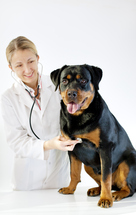Canine Cataracts
 A cataract is an abnormal opacity of the lens of the eye. In dogs, as in humans, cataracts result in blurred vision. Small cataracts may not disturb the vision much, if at all, but as cataracts grow and thicken they become more problematic and may eventually lead to blindness. Although most cataracts cannot be prevented, there are available treatments. Cataracts are rarely found in cats.
A cataract is an abnormal opacity of the lens of the eye. In dogs, as in humans, cataracts result in blurred vision. Small cataracts may not disturb the vision much, if at all, but as cataracts grow and thicken they become more problematic and may eventually lead to blindness. Although most cataracts cannot be prevented, there are available treatments. Cataracts are rarely found in cats.
Causes of Cataracts
Cataracts may be caused by aging, disease or trauma to the eye, but canine cataracts are most commonly an inherited condition. They may be congenital or may develop in young dogs, between 1 and 3 years of age. In many cases, canine cataracts are the result of diabetes.
Any dog may develop cataracts, but certain breeds are more prone to this disorder. These breeds include:
- Cocker spaniels
- Poodles
- Miniature schnauzers
- Terriers
- Golden retrievers
Once a dog develops cataracts, intervention may be necessary to preserve vision.
Symptoms of Cataracts
Because dogs cope with slight visual difficulties very well, the first observable symptom may be the appearance of a cloudy or blue-gray film over the eye. The eyes of older dogs, however, may appear cloudy or gray due to natural aging, a condition known as nuclear sclerosis. While nuclear sclerosis is not as dangerous as cataracts, any dog whose eyes appear cloudy should be examined by a veterinarian.
Regular veterinary examinations are always important in protecting a dog's eyesight, whether or not the dog's eyes appear cloudy, because the doctor will detect other conditions that may threaten vision, such as diabetes. Dogs who seem to be having difficulty seeing should, of course, always be examined as soon as possible.
Diagnosis of Cataracts
Cataracts are diagnosed by an eye examination. If the veterinarian detects any indication of cataracts or other eye disease, rather than some other underlying condition, a consultation with a veterinary ophthalmologist may be recommended. The specialist, who may put drops in the dog's eye to more accurately visualize the area, will be better able to assess the extent of the cataracts.
Prompt diagnosis is important because an untreated cataract may break loose to float in the eye. If the tissue settles in such a way that it blocks natural drainage of eye fluid, glaucoma may result. Glaucoma, in turn, may lead to blindness.
It is also possible that the cataracts may eventually dissolve. This can cause deep, painful eye inflammation.
Treatment of Cataracts
Dogs with cataracts can be treated surgically. The veterinary ophthalmologist can remove the damaged lens and insert an artificial one in its place. Although canine cataract surgery has a high rate of success, a great deal of postoperative care is required. Not all dogs are considered good candidates for this surgery. During the healing process, the dog will have to wear a protective collar and be kept as calm as possible. Eye drop administration will also be necessary for a few weeks.
